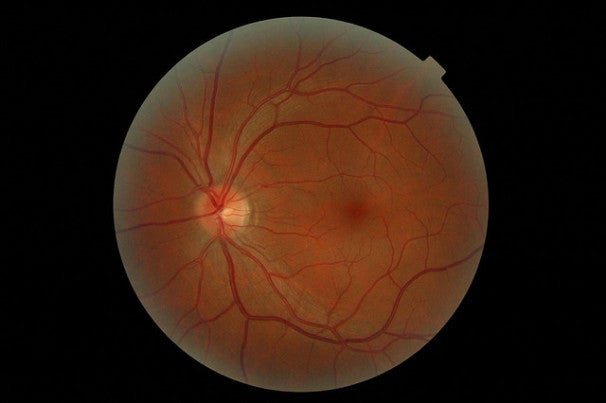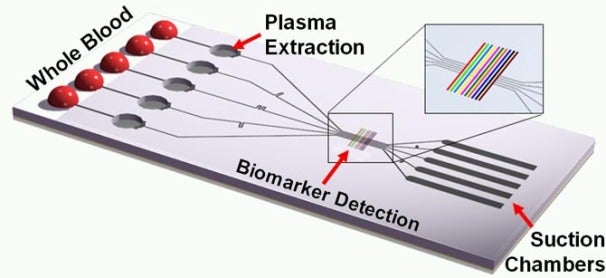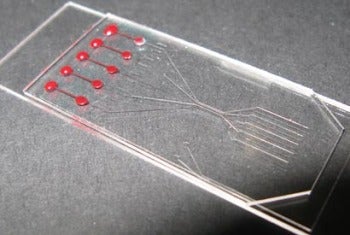The smallest electrical motor on the planet, at least according to Guinness World Records, is 200 nanometers. Granted, that's a pretty small motor -- after all, a single strand of human hair is 60,000 nanometers wide -- but that tiny mark is about to be shattered in a big way.
Chemists at Tufts University's School of Arts and Sciences have developed the world's first single molecule electric motor, a development that may potentially create a new class of devices that could be used in applications ranging from medicine to engineering.
In research published online Sept. 4 in Nature Nanotechnology, the Tufts team reports an electric motor that measures a mere 1 nanometer across, groundbreaking work considering that the current world record is a 200 nanometer motor. A single strand of human hair is about 60,000 nanometers wide.
According to E. Charles H. Sykes, Ph.D., associate professor of chemistry at Tufts and senior author on the paper, the team plans to submit the Tufts-built electric motor to Guinness World Records.
"There has been significant progress in the construction of molecular motors powered by light and by chemical reactions, but this is the first time that electrically-driven molecular motors have been demonstrated, despite a few theoretical proposals," says Sykes. "We have been able to show that you can provide electricity to a single molecule and get it to do something that is not just random."
Sykes and his colleagues were able to control a molecular motor with electricity by using a state of the art, low-temperature scanning tunneling microscope (LT-STM), one of about only 100 in the United States. The LT-STM uses electrons instead of light to "see" molecules.
The team used the metal tip on the microscope to provide an electrical charge to a butyl methyl sulfide molecule that had been placed on a conductive copper surface. This sulfur-containing molecule had carbon and hydrogen atoms radiating off to form what looked like two arms, with four carbons on one side and one on the other. These carbon chains were free to rotate around the sulfur-copper bond.
The team determined that by controlling the temperature of the molecule they could directly impact the rotation of the molecule. Temperatures around 5 Kelvin (K), or about minus 450 degrees Fahrenheit (ºF), proved to be the ideal to track the motor's motion. At this temperature, the Tufts researchers were able to track all of the rotations of the motor and analyze the data.
While there are foreseeable practical applications with this electric motor, breakthroughs would need to be made in the temperatures at which electric molecular motors operate. The motor spins much faster at higher temperatures, making it difficult to measure and control the rotation of the motor.
"Once we have a better grasp on the temperatures necessary to make these motors function, there could be real-world application in some sensing and medical devices which involve tiny pipes. Friction of the fluid against the pipe walls increases at these small scales, and covering the wall with motors could help drive fluids along," said Sykes. "Coupling molecular motion with electrical signals could also create miniature gears in nanoscale electrical circuits; these gears could be used in miniature delay lines, which are used in devices like cell phones."
The Changing Face of Chemistry
Students from the high school to the doctoral level played an integral role in the complex task of collecting and analyzing the movement of the tiny molecular motors.
"Involvement in this type of research can be an enlightening, and in some cases life changing, experience for students," said Sykes. "If we can get people interested in the sciences earlier, through projects like this, there is a greater chance we can impact the career they choose later in life."
As proof that gaining a scientific footing early can matter, one of the high school students involved in the research, Nikolai Klebanov, went on to enroll at Tufts; he is now a sophomore majoring in chemical engineering.
This work was supported by the National Science Foundation, the Beckman Foundation and the Research Corporation for Scientific Advancement.
Source science daily web
In research published online Sept. 4 in Nature Nanotechnology, the Tufts team reports an electric motor that measures a mere 1 nanometer across, groundbreaking work considering that the current world record is a 200 nanometer motor. A single strand of human hair is about 60,000 nanometers wide.
According to E. Charles H. Sykes, Ph.D., associate professor of chemistry at Tufts and senior author on the paper, the team plans to submit the Tufts-built electric motor to Guinness World Records.
"There has been significant progress in the construction of molecular motors powered by light and by chemical reactions, but this is the first time that electrically-driven molecular motors have been demonstrated, despite a few theoretical proposals," says Sykes. "We have been able to show that you can provide electricity to a single molecule and get it to do something that is not just random."
Sykes and his colleagues were able to control a molecular motor with electricity by using a state of the art, low-temperature scanning tunneling microscope (LT-STM), one of about only 100 in the United States. The LT-STM uses electrons instead of light to "see" molecules.
The team used the metal tip on the microscope to provide an electrical charge to a butyl methyl sulfide molecule that had been placed on a conductive copper surface. This sulfur-containing molecule had carbon and hydrogen atoms radiating off to form what looked like two arms, with four carbons on one side and one on the other. These carbon chains were free to rotate around the sulfur-copper bond.
The team determined that by controlling the temperature of the molecule they could directly impact the rotation of the molecule. Temperatures around 5 Kelvin (K), or about minus 450 degrees Fahrenheit (ºF), proved to be the ideal to track the motor's motion. At this temperature, the Tufts researchers were able to track all of the rotations of the motor and analyze the data.
While there are foreseeable practical applications with this electric motor, breakthroughs would need to be made in the temperatures at which electric molecular motors operate. The motor spins much faster at higher temperatures, making it difficult to measure and control the rotation of the motor.
"Once we have a better grasp on the temperatures necessary to make these motors function, there could be real-world application in some sensing and medical devices which involve tiny pipes. Friction of the fluid against the pipe walls increases at these small scales, and covering the wall with motors could help drive fluids along," said Sykes. "Coupling molecular motion with electrical signals could also create miniature gears in nanoscale electrical circuits; these gears could be used in miniature delay lines, which are used in devices like cell phones."
The Changing Face of Chemistry
Students from the high school to the doctoral level played an integral role in the complex task of collecting and analyzing the movement of the tiny molecular motors.
"Involvement in this type of research can be an enlightening, and in some cases life changing, experience for students," said Sykes. "If we can get people interested in the sciences earlier, through projects like this, there is a greater chance we can impact the career they choose later in life."
As proof that gaining a scientific footing early can matter, one of the high school students involved in the research, Nikolai Klebanov, went on to enroll at Tufts; he is now a sophomore majoring in chemical engineering.
This work was supported by the National Science Foundation, the Beckman Foundation and the Research Corporation for Scientific Advancement.
Source science daily web





















